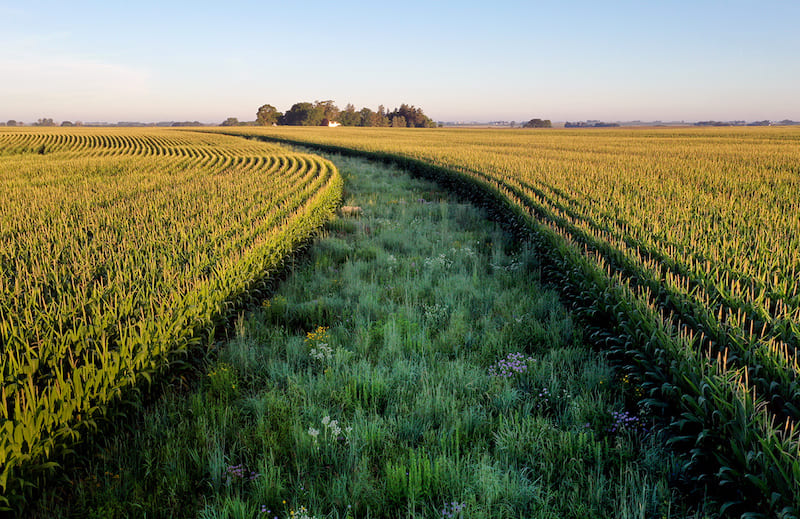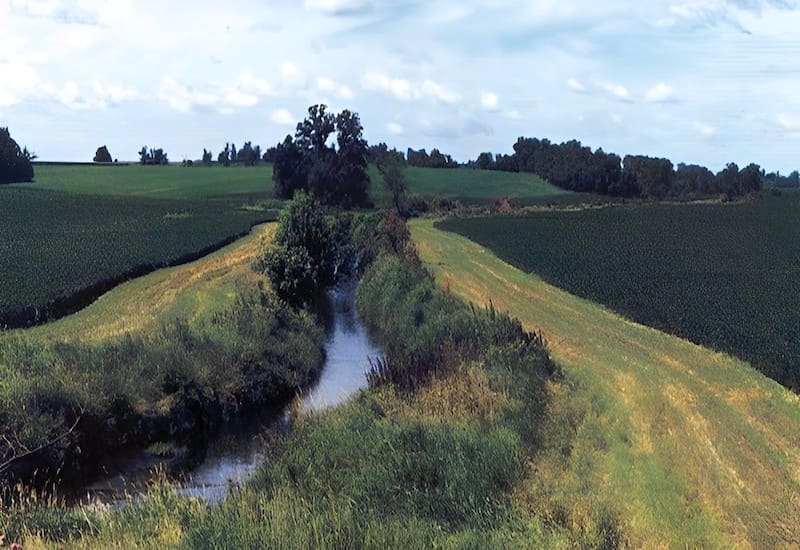
A buffer strip, also known as a riparian buffer zone or buffer zone, is a vegetated area near a stream or other body of water which helps to protect that water source from the impact of adjacent land use, most commonly in agricultural or urban settings.
Buffer strips create sustainable landscapes. They can help prevent soil erosion by using vegetation to stabilize the soil and decrease the potential for water runoff. They also filter out pollutants that might run off from the land such as fertilizers, pesticides, and sediments into streams, rivers, and lakes, which improves water quality.
Buffer strips also provide habitat for a wide range of wildlife including aquatics and help increase biodiversity by creating transitional habitat between land and water. This is especially crucial in developed urban areas or large mono-agricultural farms where habitat is limited.
Buffer strips can also play a role in carbon sequestration to mitigate the effects of climate change, as most vegetation absorbs carbon dioxide from the atmosphere. They can help regulate the temperature of adjacent waterways by providing shade, and they can help manage flooding by absorbing an excess overflow of water.
Overall, buffer strips are an important tool for land and waterway management, providing a range of environmental benefits that promote both ecological health and sustainability, particuarily with regards to riparian efforts.

Start by identifying the suitable areas for buffer strips in your landscape. This typically includes riparian zones, or the areas adjacent to bodies of water like streams, rivers, or lakes. Carry out a detailed assessment of these areas considering factors like slope, soil type, existing vegetation, and potential sources of runoff.
The width of the buffer strip may vary depending on its intended function, the local landscape, and any specific regulatory guidelines. A wider strip is generally more effective in erosion control and pollutant filtration. Consider the type of crops, proximity to water bodies, and the nature of the slope while deciding the width.
Design the buffer strip taking into account the species of plants that will be used. It's generally recommended to use a combination of grasses, shrubs, and trees. The arrangement should transition from shorter plants like grasses at the outer edge (closer to the farm field) to taller plants like trees at the inner edge (closer to the water body).
Choose native plant species that are well-adapted to local conditions. Native plants often have deep root systems ideal for soil stabilization and are more resistant to local pests and diseases. Make sure to use a mix of species to enhance biodiversity.
Clear the designated area of any unwanted debris or vegetation. Prepare the soil for planting, which may involve tilling or amending the soil if required.
Once the land is ready, begin planting the selected vegetation according to your design. It's typically best to start this process in the growing season to ensure the plants have a good chance to establish.
Regularly check the buffer strip for signs of erosion or pollutant build-up. Remove any invasive species that appear and replace any plants that do not survive. The effectiveness of the buffer strip should be monitored periodically to ensure it is performing its intended functions.
Creating a buffer strip can be a great investment in your land. While it may require some time and effort to establish, the long-term benefits to soil health, water quality, and local biodiversity make it a worthwhile endeavor for any land manager.
Buffer strips are a critical strategy for combating soil erosion. They function as water flow mechanism, slowing down the speed of water runoff, and reducing the capacity for soil to be displaced and washed away. This reduced velocity significantly curtails the erosive power of water, thus serving as a natural protection against soil degradation and erosion.
The effectiveness of buffer strips lies in the strategic use of vegetation, typically native to the area. A vegetative buffer zone is not merely surface adornment; rather, it serves a functional purpose. The vegetation, with its extensive and deep-reaching root systems, weaves a natural web under the ground; a root network that acts as a living anchor, securing both soil and the subterranean ecosystem from the destructive forces of flowing water.
The binding property of a buffer strip highlights their effectiveness and illustrates how they harness the power of plants to hold the soil together, combat erosion, and contribute to the overall sustainability of the landscape.

Buffer strips serve as nature's very own filtration system, offering a line of defense against various pollutants that may otherwise seep into streams, rivers, and lakes. Often strategically placed between agricultural fields and waterways, they play an essential role in trapping pollutants such as pesticides, fertilizers, and sediment before they can reach and contaminate a body of water.
The filtration process is activated by the dense vegetation in the buffer strips. When rainwater or irrigation water flows over the surface of the land, it may pick up various pollutants. As this runoff reaches the buffer strip, it is slowed down by the vegetation. This decrease in velocity causes heavier particles, like sediment and particulate matter, to settle out of the water among the roots of the plants.
At the same time, dissolved contaminants such as nitrates and phosphates from fertilizers are taken up by the vegetation and microorganisms present in the soil, effectively purifying the water source. Through this process, buffer strips help reduce nutrient loading in runoff, preventing the occurrence of harmful algal blooms and other water quality issues. Thus, buffer strips serve as a natural, efficient, and sustainable method of water purification.
Buffer strips located in riparian zones – the crucial junction between terrestrial and aquatic environments, play a significant role in maintaining biodiversity. Riparian zones are ecotones, inherently rich with all types of diverse life forms. They host a unique convergence of land and water ecosystems creating biodiversity hotspots, which offer a protective habitat that encourages habitation by a multitude of species.
These buffer zones, teeming with vegetation, serve as a refuge for a broad spectrum of wildlife, from birds and mammals to invertebrates and microorganisms. They offer abundant food resources, nesting and breeding spaces, and cover for a multitude of species. Beyond providing a habitat, buffer strips play a critical role in landscape connectivity. They function as biological corridors or green bridges, enabling safe passage for wildlife. This not only promotes the movement of species across landscapes but also facilitates genetic diversity by allowing for the intermingling of species from one area to another.
Riparian zone buffer strips are not just physical barriers against erosion or filters for pollutants, but they are also dynamic systems that sustain life and contribute to the overall health of sustainable landscapes.

Buffer strips, often depicted as green bridges or biological corridors, not only connect habitats and shield waterways but also hold a formidable weapon in the global fight against climate change: carbon sequestration, which refers to the absorption and long-term storage of carbon dioxide from the atmosphere, a greenhouse gas mostly responsible for global warming and climate change.
These ribbons of vegetation grow lush with a variety of plants, each acting as a mini carbon sink. Through photosynthesis, plants intake carbon dioxide from the atmosphere and convert it into glucose for growth, while releasing oxygen back into the atmosphere. Thus, each plant within the buffer strip actively contributes to the reduction of atmospheric carbon dioxide levels, serving as an agent for carbon sequestration.
Buffer strips can be looked upon as green warriors, harnessing the power of plants to offset greenhouse gas emissions and promote the overall health and sustainability of our landscapes.
Buffer strips not only serve as biological filters and biodiversity supporters but also play a unique role of controlling the temperature of adjacent water bodies. This thermal regulation is an often overlooked yet is critical for the development and protection of aquatic ecosystems.
Standing as a natural barrier between the sun's harsh rays and the surface of the water, buffer strips provide shade to nearby streams, rivers, or lakes. This leaf cover acts as a natural cooling system, preventing water temperatures from reaching levels that could be harmful to aquatic life.
A consistent rise in water temperature can lead to a decrease in dissolved oxygen levels, which are vital for the survival of many aquatic organisms. Furthermore, high temperatures can directly affect the metabolism and behavior of aquatic species, threatening their reproductive capabilities and the overall balance of the ecosystem.
By maintaining cooler water temperatures, buffer strips help to ensure the health and stability of these aquatic ecosystems, contributing to the sustainability and resilience of the broader landscape.
Buffer strips are more than just lines of vegetation on a landscape; they are versatile tools employed in effective land management. They work as green sponges, nutrient filters, wildlife corridors, and carbon absorbers, thereby enhancing the sustainability and productivity of landscapes.
Employed as a central component of conservation practices, buffer strips serve a protective role, safeguarding soils from erosion, purifying runoff to improve water quality, and providing valuable habitats for a plethora of species.
They create a unique habitat provision, housing a wide range of organisms, from tiny microorganisms in the soil to larger mammals that utilize the strips as migration corridors.
Furthermore, buffer strips also act as carbon sequestration sites, contributing to the global fight against climate change by removing carbon dioxide from the atmosphere.
Ready to transform your land into a high-yield, sustainable farm? Let Crop Circle Farms design and build a custom, low-impact, and water-efficient farm tailored to your needs. Double your income and cut your costs in half! Contact Us
Help us expand our mission to revolutionize agriculture globally. We are seeking partners to implement Crop Circle Farms to feed people in need. Together, we can build scalable food production systems that save water, reduce costs, and feed thousands of people. Contact Growing To Give